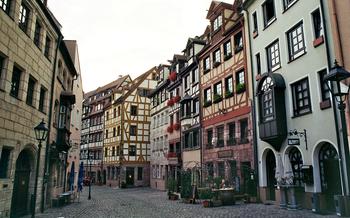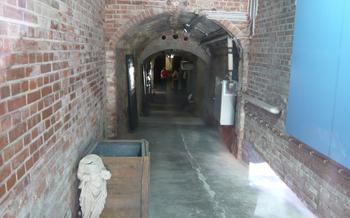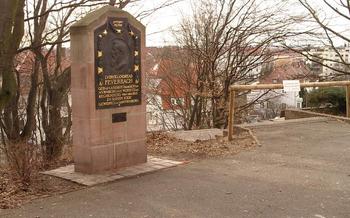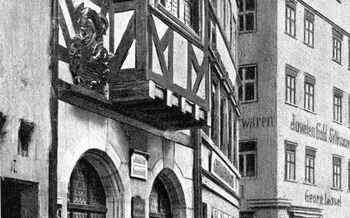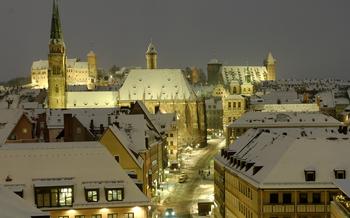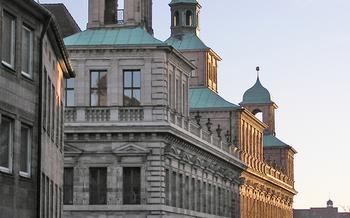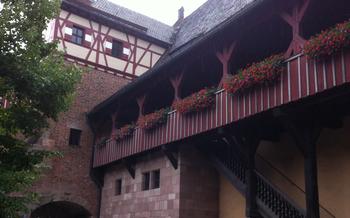
Kunstbunker Tiefbunker unter dem Altstadthof
- A Hidden Gem in Nuremberg
- Architecture and Design
- Art and Cultural Significance
- Guided Tours
- Exhibits and Displays
- Interactive Experiences
- Historical Artifacts
- Educational Programs
- Accessibility and Facilities
- Photography and Videography
- Visitor Etiquette
- Local Recommendations
- Insider Tip: Unraveling the Hidden Secrets of the Kunstbunker
A Hidden Gem in Nuremberg
Nestled beneath the historic Altstadt of Nuremberg liesthof. This former air-raid shelter, constructed during World War II, has been transformed into a unique art space, showcasing an array of captivating exhibitions and installations. Its discovery in 1994 revealed a treasure trove of preserved artwork that had miraculously survived the ravages of war. Today, the Kunstbunker stands as a testament to the resilience of art and the power of human creativity in the face of adversity.
Architecture and Design
The Kunstbunker Tiefbunker unter dem Altstadthof is a remarkable example of underground architecture and engineering. Built entirely underground, the bunker consists of a series of interconnected tunnels and chambers that extend deep beneath the city. Its unique design allowed it to withstand the destructive power of Allied bombing raids during World War II and protected the valuable artworks stored within.
The bunker's underground location not only served a protective purpose but also created a unique and atmospheric environment for displaying art. The dimly lit tunnels and chambers, with their rough-hewn walls and arched ceilings, create an immersive and intimate setting for visitors to engage with the artworks. The bunker's subterranean nature also provides a sense of isolation and seclusion, allowing visitors to focus on the art without distractions from the outside world.
One of the most striking features of the bunker is its massive steel door, which weighs several tons and is designed to withstand immense pressure. This door, along with the bunker's reinforced concrete walls and ceilings, contributed to its ability to protect the artworks during the war. The bunker's design also included a sophisticated ventilation system to ensure a constant supply of fresh air and to prevent the buildup of humidity, which could damage the artwork.
Art and Cultural Significance
The Kunstbunker Tiefbunker unter dem Altstadthof is not just a historical relic but also a vibrant cultural hub, hosting a variety of art exhibitions and events throughout the year. These exhibitions showcase the works of local, national, and international artists, spanning various mediums and genres. From contemporary paintings and sculptures to installations and multimedia displays, the bunker provides a unique and immersive platform for artistic expression.
The bunker's underground location adds a distinct atmosphere to the art exhibitions, creating an intimate and contemplative space for visitors to engage with the artworks. The bunker's history as a shelter during World War II also lends a poignant context to the art, inviting visitors to reflect on the complexities of war, resilience, and the power of art to transcend adversity.
Among the notable artworks displayed in the bunker is a series of paintings depicting life in Nuremberg during the war, capturing the struggles, fears, and hopes of ordinary citizens. Visitors can also admire a collection of sculptures made from recycled materials, highlighting the creative potential of repurposing and sustainability.
The bunker's commitment to promoting local art is evident in the regular exhibitions featuring emerging and established artists from the Nuremberg region. These exhibitions provide a platform for local talent to showcase their work and connect with a wider audience, fostering a vibrant arts community within the city.
Guided Tours
For an immersive and informative experience, visitors to the Kunstbunker Tiefbunker unter dem Altstadthof can embark on a guided tour. These tours are conducted by knowledgeable guides who provide insights into the bunker's history, architecture, and cultural significance. During the tour, visitors will explore the various levels of the bunker, including the exhibition spaces, storage rooms, and technical areas. Guides will share stories and anecdotes about the bunker's construction, its role during World War II, and its transformation into an art venue.
Tours are offered on a regular basis and can be booked in advance online or at the bunker's information desk. Prices vary depending on the tour type and group size. Visitors are advised to check the bunker's website or contact the information desk for up-to-date information on tour schedules, prices, and booking procedures.
Exhibits and Displays
The Kunstbunker Tiefbunker unter dem Altstadthof houses a diverse range of exhibits and displays that offer a comprehensive insight into its history and significance. Visitors can explore the bunker's original construction, its role during World War II, and its transformation into an art and cultural center.
One of the key exhibits focuses on the engineering and architectural aspects of the bunker. Detailed plans, diagrams, and models showcase the innovative design and construction techniques used to create this underground fortress. Visitors can learn about the bunker's unique features, such as its reinforced concrete structure, air filtration system, and emergency escape routes.
Another exhibit delves into the human stories associated with the bunker. Visitors can read firsthand accounts from former soldiers, civilians, and prisoners who experienced the bunker during the war. These personal narratives shed light on the hardships, fears, and resilience of those who lived and worked in this subterranean environment.
Furthermore, the bunker showcases a rotating array of contemporary art exhibitions. Local and international artists use the unique space to create immersive installations, sculptures, and paintings that explore themes related to war, peace, memory, and the human condition. These exhibitions offer a fresh perspective on the bunker's history and encourage visitors to reflect on its enduring legacy.
Each exhibit is thoughtfully curated and presented with informative panels, multimedia displays, and interactive elements. Visitors can engage with the history and art of the bunker at their own pace, gaining a deeper understanding of this remarkable site.
Interactive Experiences
For an engaging and immersive experience, visitors to the Kunstbunker Tiefbunker unter dem Altstadthof can participate in various interactive exhibits and activities. These elements add a dynamic dimension to the museum, allowing visitors to engage with history and art in a hands-on manner.
One popular interactive display is a replica of a bomb shelter, complete with authentic furnishings and artifacts. Visitors can step inside the shelter and experience firsthand the cramped and claustrophobic conditions that civilians faced during air raids. The exhibit provides a visceral reminder of the hardships endured by the population during World War II.
Another interactive element is a touch screen display that allows visitors to explore the history of the bunker and its role in the war. Interactive maps, timelines, and photographs bring the past to life, providing a deeper understanding of the bunker's significance.
For younger visitors, there is a dedicated children's area with interactive games and activities related to the bunker and World War II. This engaging space allows children to learn about history while having fun, making the museum an enjoyable and educational experience for the whole family.
Historical Artifacts
The Kunstbunker Tiefbunker unter dem Altstadthof houses a remarkable collection of historical artifacts that offer a tangible connection to the bunker's past and the events of World War II. Among these artifacts, visitors can find:
-
Original Gas Masks and Protective Gear: These well-preserved items provide a glimpse into the precautions taken by civilians during air raids and gas attacks.
-
Authentic Documents and Photographs: These records offer a firsthand account of life in Nuremberg during the war, including ration cards, propaganda posters, and personal photographs.
-
Military Equipment: The bunker showcases various military artifacts, such as helmets, uniforms, and weapons, which shed light on the experiences of soldiers and the harsh realities of combat.
-
Personal Belongings: The display of personal items, such as diaries, letters, and toys, humanizes the stories of those who sought refuge in the bunker, adding a poignant dimension to the historical narrative.
Each artifact tells a unique story, offering visitors a deeper understanding of the challenges and sacrifices endured by the people of Nuremberg during World War II.
Educational Programs
The Kunstbunker Tiefbunker unter dem Altstadthof is not just a place to admire art and history; it also serves as a vibrant educational platform. The bunker hosts a range of educational programs and workshops designed to engage visitors of all ages, particularly school groups and students. These programs aim to deepen the understanding of World War II, art, and cultural heritage.
One of the most popular programs is the "History of the Bunker" workshop, which takes participants on a journey through the bunker's construction, purpose, and role during the war. Through interactive activities and multimedia presentations, students gain insights into the lives of those who sought refuge within the bunker's walls.
Another program, "Art in the Bunker," explores the significance of art in times of conflict. Participants learn about the role of art as a form of resistance, expression, and healing. They also get hands-on experience creating their own art inspired by the bunker's unique atmosphere.
The bunker's educational programs are not limited to the classroom. Guided tours often incorporate interactive elements, such as quizzes, puzzles, and role-playing scenarios, to make learning fun and engaging. Visitors are encouraged to ask questions, share their thoughts, and engage in discussions with the knowledgeable guides.
The success of the educational programs is evident in the enthusiastic feedback from participants. Teachers appreciate the opportunity to bring history to life for their students, while students express their awe and amazement at the stories and experiences they encounter within the bunker's walls.
The Kunstbunker Tiefbunker unter dem Altstadthof is a testament to the power of education in preserving history and fostering cultural understanding. Through its educational programs, the bunker continues to inspire and educate generations, ensuring that the lessons of the past are never forgotten.
Accessibility and Facilities
The Kunstbunker is committed to ensuring that all visitors, regardless of their abilities, have a fulfilling and accessible experience. Wheelchair users and individuals with limited mobility can easily navigate the bunker's ground level, which houses the main exhibition space, gift shop, and restrooms. Ramps and elevators provide convenient access to all levels of the bunker, allowing visitors to explore the exhibits comfortably.
For those who require additional assistance, the bunker staff is always ready to provide support. They can arrange for wheelchairs to be available upon request and offer guidance to ensure a smooth and enjoyable visit. Furthermore, the bunker features designated seating areas where visitors can rest and take a break from their exploration. These thoughtful touches demonstrate the bunker's dedication to creating an inclusive environment for all its visitors.
Photography and Videography
The Kunstbunker encourages visitors to capture their experiences through photography and videography. However, to ensure the preservation of the exhibits and the comfort of other visitors, certain guidelines must be followed.
Flash photography and tripods are not permitted within the bunker. This helps prevent damage to the delicate artworks and installations. Visitors are requested to use natural light or low-light settings on their cameras.
While taking photos and videos, it is essential to be mindful of other visitors. Avoid blocking their view or disrupting their experience. It is also important to respect the privacy of other visitors by not taking their photos or videos without their consent.
The bunker's unique atmosphere and captivating exhibits make it an ideal location for capturing creative content. Whether you're a professional photographer, a budding videographer, or simply an enthusiast looking to document your visit, the Kunstbunker offers ample opportunities for artistic expression.
Visitor Etiquette
The Kunstbunker Tiefbunker unter dem Altstadthof is a place of historical significance and cultural importance. As visitors, it is essential to respect the sanctity of the space and the experiences of fellow visitors. Here are some guidelines to ensure a respectful and enriching visit:
Silence and Sobriety: Maintain a respectful silence within the bunker. The serene atmosphere allows for contemplation and reflection on the somber history of the space.
Respect for Exhibits: Treat the artifacts, artworks, and displays with the utmost care. Refrain from touching or leaning on exhibits, and avoid placing personal belongings on display cases.
Consideration for Others: Be mindful of the space and the experience of other visitors. Avoid blocking pathways, talking loudly, or distracting others from their contemplation.
Photography Etiquette: While photography is generally permitted, be considerate of the privacy of other visitors and the sanctity of the space. Avoid using flash photography, and always ask for permission before photographing individuals.
Respect for the Past: Remember that the bunker holds stories of resilience, suffering, and loss. Respect the memories of those who lived through this period by behaving in a manner that honors their experiences.
By following these guidelines, visitors can contribute to a respectful and meaningful experience for themselves and others, allowing everyone to gain a deeper understanding of the history and significance of the Kunstbunker.
Local Recommendations
After immersing yourself in the history and art of the Kunstbunker, take some time to explore the vibrant city of Nuremberg. For a culinary adventure, head to Albrecht Dürer Stube, a traditional German restaurant known for its hearty Franconian dishes and cozy ambiance. Savor the flavors of local specialties like Schäufele (roasted pork shoulder) and Nürnberger Rostbratwürste (grilled Nuremberg sausages).
For a taste of Nuremberg's rich history, visit the Albrecht Dürer House, where the renowned Renaissance artist Albrecht Dürer lived and worked. Explore his former studio and admire his intricate engravings, paintings, and drawings that capture the essence of the city and its people.
To experience Nuremberg's modern side, stroll along the Pegnitz River and soak in the picturesque views of the city's bridges and half-timbered houses. Discover the charm of the Old Town, with its narrow cobblestone streets, colorful facades, and hidden courtyards.
As the sun sets, immerse yourself in the lively atmosphere of Nuremberg's Hauptmarkt, the city's central square. Admire the intricate details of the Gothic Frauenkirche (Church of Our Lady) and the Schöner Brunnen (Beautiful Fountain), a masterpiece of medieval craftsmanship.
Nuremberg offers a blend of history, culture, and modern attractions, ensuring a memorable and enriching experience for every visitor.
Insider Tip: For a unique souvenir, visit the Lebkuchen Schmidt, a traditional gingerbread bakery that has been delighting locals and tourists alike since 185Indulge in their freshly baked Lebkuchen (gingerbread cookies), a sweet treat that embodies the flavors and traditions of Nuremberg.
Insider Tip: Unraveling the Hidden Secrets of the Kunstbunker
As you explore the depths of the Kunstbunker, keep an eye out for a hidden gem that few visitors notice. Tucked away in a secluded corner, you'll find a small, unassuming door. Behind it lies a secret chamber, once used as a storage space for valuable artworks during the war. Today, it houses a collection of forgotten treasures, including old photographs, sketches, and personal belongings that offer a glimpse into the lives of those who sought refuge within these walls. Discover the stories behind these relics and uncover the hidden layers of history that make the Kunstbunker a truly captivating place.
